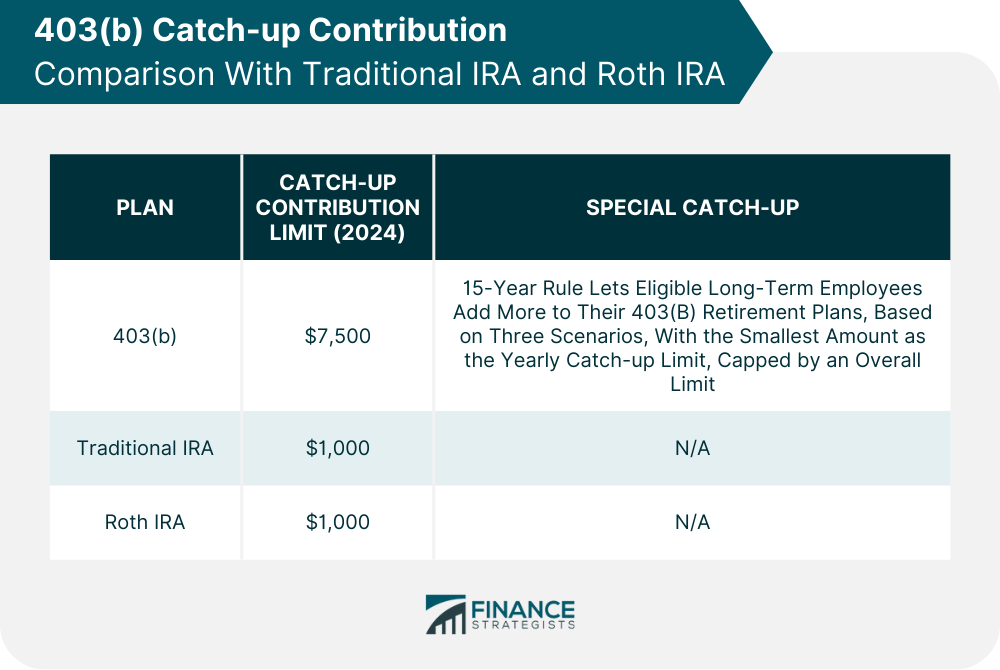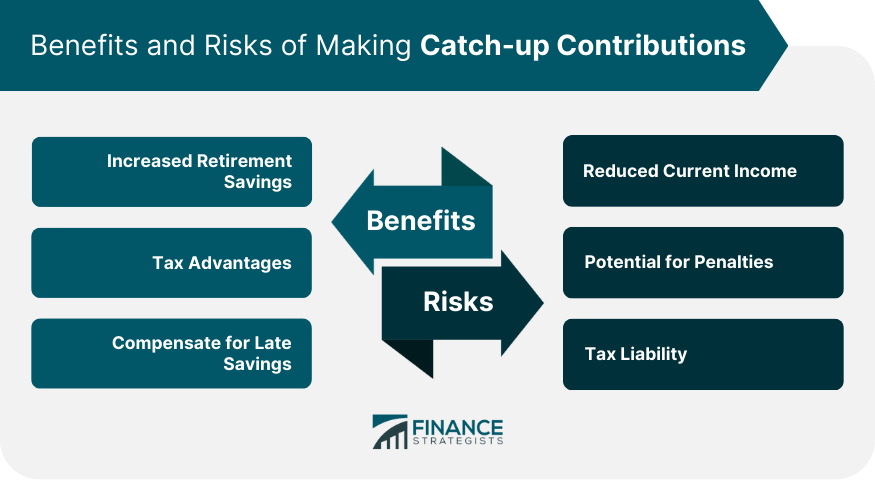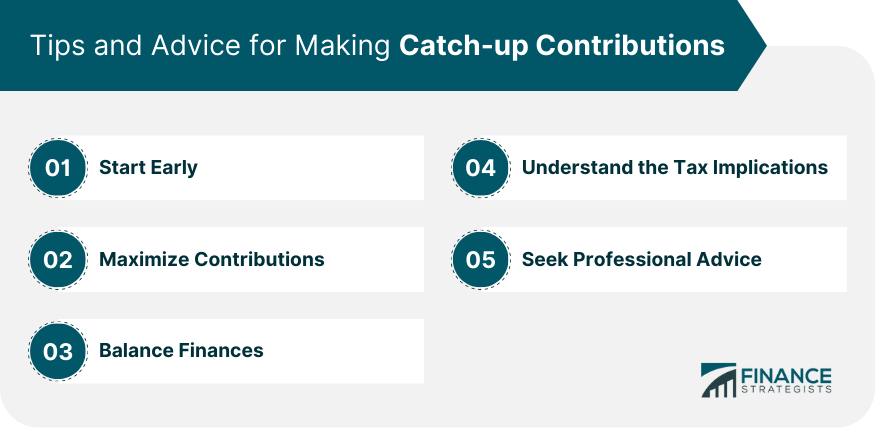A 403(b) plan is a type of retirement savings plan that is offered to employees of certain public schools, non-profit organizations, and religious institutions. One of the features of this plan is the option to make 403(b) catch-up contributions under certain conditions. A 403(b) Catch-Up Contribution is an additional contribution to a 403(b) retirement savings plan that exceeds the standard contribution limit. This option is available to individuals aged 50 or older and those who have worked for the same eligible organization for at least 15 years. As of 2024, the additional contribution can be up to $7,500 per year for age-based catch-ups and $3,000 per year (up to a lifetime limit of $15,000) for the 15-year rule catch-up. The importance of 403(b) Catch-Up Contributions lies in their ability to significantly boost retirement savings. They allow individuals nearing retirement to bolster their savings, increasing their financial security in the future. The tax-deductible nature of these contributions also offers the immediate benefit of reducing current taxable income. Individuals who qualify for age-based catch-up contributions simply need to adjust their contribution amount with their employer's benefits administrator. The calculation for these contributions is straightforward: it's a flat amount ($7,500 for 2024) that gets added to the annual limit. Employees of qualified organizations can contribute an additional amount to their 403(b) retirement savings plans under this rule. They must have worked for the same organization for at least 15 years, and their average contribution must have been less than $5,000 per year. A qualified organization is one that meets certain criteria set by the IRS, such as a public school system, hospital, or church. Here's a step-by-step guide to calculating the 15-Year Rule Catch-up Contributions : Calculate Years of Service: Determine the number of years you’ve worked for your current organization. Calculate Cumulative Deferrals: Add up all the elective deferrals you’ve made to the 403(b) plan in your years of service. Flat $3,000 Limit: This is the simplest scenario where the maximum you can contribute is $3,000. Lifetime $15,000 Limit: Subtract the total amount of 15-year rule catch-up contributions made in prior years from $15,000. If you’ve made $5,000 in additional elective deferrals in the past, you can contribute a maximum of $10,000 ($15,000 - $5,000). Years of Service Minus Previous Deferrals: Multiply your years of service by $5,000 and subtract the total of your past elective deferrals. For example, if you’ve worked for your organization for 20 years and made a total of $50,000 in deferrals over that period, you can contribute a maximum of $50,000 ($100,000 - $50,000). The lowest of these three amounts is your catch-up contribution limit for the year. However, this limit is also subject to the overall limit of IRC Section 415, which is $69,000 for 2024. This means that your total contributions (including employer contributions and other elective deferrals) cannot exceed this amount. In some cases, individuals can take advantage of both catch-up contribution options. However, the total contribution cannot exceed the individual's taxable income for the year. If you qualify for both types, the IRS states that contributions should be first applied to the 15-year catch-up and then to the age-based catch-up. For example, if John, a 52-year-old teacher, has been with his school for 20 years and hasn't fully utilized the 15-year catch-up, he could first apply his additional contributions to the 15-year catch-up until he reaches the $3,000 limit. Any contributions beyond that would then count towards the age-based catch-up. Tax Deductibility: The catch-up contributions to a 403(b) plan are made on a pre-tax basis, which means they are tax-deductible in the year they are made. Tax on Withdrawals: Upon withdrawal in retirement, the distributions are subject to income tax. Early Withdrawal Penalties and Exceptions: Withdrawals made before age 59.5 may be subject to a 10% early withdrawal penalty unless a specific exception applies. 403(b) plans to share a lot of similarities with 401(k) plans, especially regarding catch-up contributions. Both plans allow individuals aged 50 and above to make catch-up contributions to boost their retirement savings. The limit for these contributions is also the same for both plans, capped at $7,500 per year as of 2024. However, one distinctive feature of 403(b) plans is the 15-year rule. This unique aspect allows long-term employees of non-profit organizations who have worked for the same employer for at least 15 years to make additional contributions above the standard limit. This feature is not available in 401(k) plans, making the 403(b) plan potentially more advantageous for employees who have dedicated many years to the same organization. Traditional and Roth IRAs also offer catch-up contributions for individuals who are aged 50 or older. However, the limits for these contributions are significantly lower compared to 403(b) plans. As of 2024, the catch-up contribution limit for IRAs is $1,000, which is substantially less than the $7,500 allowed in 403(b) and 401(k) plans. It's important to note that while 403(b) plans have higher catch-up contribution limits, IRAs, especially Roth IRAs, offer different tax advantages. For instance, Roth IRA distributions are tax-free in retirement, which might be beneficial depending on individual tax circumstances. Thus, when comparing these retirement vehicles, one should consider not only contribution limits but also their unique tax implications and potential benefits. Increased Retirement Savings: Catch-up contributions allow individuals nearing retirement to significantly increase their savings, enhancing their financial security in their retirement years. Tax Advantages: Since these contributions are made on a pre-tax basis, they reduce current taxable income, potentially placing the individual in a lower tax bracket. Compensate for Late Savings: For those who may have started saving for retirement later in life, catch-up contributions provide an opportunity to make up for lost time. Reduced Current Income: Making catch-up contributions could tie up more of your current income, leaving less for daily living expenses. Potential for Penalties: Money invested in a 403(b) is harder to access until you reach retirement age. Early withdrawals can result in penalties unless specific exceptions apply. Tax Liability: While catch-up contributions offer immediate tax benefits, it's important to remember that distributions in retirement are subject to income tax. 1. Start Early: As soon as you're eligible, start making catch-up contributions. The earlier you start, the more you can accumulate toward your retirement savings. 2. Maximize Contributions: If your financial situation allows, aim to contribute the maximum allowable catch-up contribution each year. This not only boosts your retirement fund but also offers tax advantages. 3. Balance Finances: Ensure you have a balanced financial plan. While maximizing your retirement savings is important, remember to keep an adequate emergency fund and manage your current expenses. 4. Understand the Tax Implications: Make sure you understand the tax benefits and also the tax implications at the time of withdrawal. 5. Seek Professional Advice: Retirement planning can be complex, especially when it comes to maximizing your contributions. Don't hesitate to seek advice from a financial advisor or tax professional to ensure you're making the most of your 403(b) plan. 403(b) Catch-Up Contributions offer an invaluable opportunity for individuals, particularly those aged 50 and over or those who have dedicated 15 years to the same eligible organization, to accelerate their retirement savings. The provisions, which allow up to $7,500 additional annual contributions based on age and up to $3,000 based on service years, enable these individuals to significantly enhance their future financial security. Equally crucial is the reduction in current taxable income, thanks to the pre-tax nature of these contributions. However, care must be taken to balance present financial needs with future savings, to avoid penalties for early withdrawals, and to understand the potential tax liability during retirement. As retirement planning complexities intensify, professional financial or tax advice can prove invaluable. Ultimately, utilizing 403(b) Catch-Up Contributions to their fullest can be a critical strategy in achieving a comfortable and secure retirement.Overview of 403(b) Catch-up Contribution
Detailed Explanation of the Catch-up Types
Age-Based Catch-up Contributions
15-Year Rule Catch-up Contributions
Step-By-Step Guide Calculation of 15-Year Rule Catch-up Contributions
Coordinating Catch-up Contributions
When Both Types of Catch-Ups Are Applicable
Sequence of Application
Example Scenarios and Calculations
Tax Implications of 403(b) Catch-up Contributions
Comparison With Other Retirement Plans
Comparison With 401(k) Catch-up Contributions
Comparison With Traditional IRA and Roth IRA Catch-up Contributions

Benefits and Risks of Making Catch-up Contributions
Benefits
Potential Risks

Tips and Advice for Making Catch-up Contributions

Final Thoughts
403(b) Catch-up Contribution FAQs
A 403(b) catch-up contribution refers to the additional amount that individuals aged 50 or older, or those who have worked for the same eligible organization for at least 15 years, can contribute to their 403(b) retirement savings account over the standard contribution limit.
There are two types of catch-up contributions: Age-Based and 15-Year Rule. Age-Based contributions are for individuals aged 50 and older, allowing them to contribute an extra amount beyond the standard limit. The 15-Year Rule applies to employees who have worked for the same eligible organization for at least 15 years, allowing them to contribute extra to their 403(b) account.
As of 2024, the age-based catch-up contribution limit is $7,500 per year, and the 15-year rule catch-up contribution limit is $3,000 per year up to a lifetime limit of $15,000.
Catch-up contributions are made on a pre-tax basis, which means they are tax-deductible in the year they are made. However, distributions during retirement are subject to income tax. Additionally, a 10% early withdrawal penalty may apply if withdrawals are made before age 59.5 unless specific exceptions apply.
The catch-up contribution rules for a 403(b) plan are quite similar to those of a 401(k) plan, except for the unique 15-year rule in 403(b) plans. Traditional and Roth IRAs also allow catch-up contributions for those aged 50 or older, but the limits are lower than those for 403(b) plans.
True Tamplin is a published author, public speaker, CEO of UpDigital, and founder of Finance Strategists.
True is a Certified Educator in Personal Finance (CEPF®), author of The Handy Financial Ratios Guide, a member of the Society for Advancing Business Editing and Writing, contributes to his financial education site, Finance Strategists, and has spoken to various financial communities such as the CFA Institute, as well as university students like his Alma mater, Biola University, where he received a bachelor of science in business and data analytics.
To learn more about True, visit his personal website or view his author profiles on Amazon, Nasdaq and Forbes.















